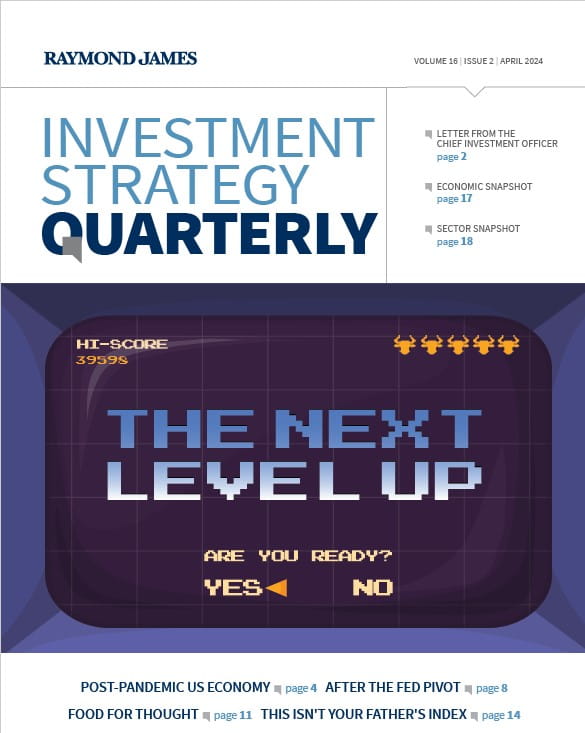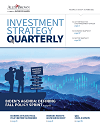Raymond James CIO Larry Adam reminds investors they need to be well prepared and ready for any challenges that may come their way.
To read the full article, see the Investment Strategy Quarterly publication linked below.
With technology changing the way we live, we are taking a trip down memory lane to look back at a piece of technology that has entertained generations: classic video games. Why? Because whether you are in a fictional gaming world or the real-life investment world, you need to be well prepared and ready for any challenges that come your way. We have these two worlds collide as we get set for the next level of play in the financial markets. Let’s hit the start button and go.
The U.S. economy has eluded obstacles and defied recessionary predictions like players in Frogger dodging cars and alligators to arrive safely home. Our economist believes that while the economy will slow meaningfully from its recent leaping pace, recessionary concerns are fading. Yes, consumer spending is likely to be challenged by rising credit card balances, falling savings rates, and less robust employment growth, but record household net worth will keep spending from collapsing. In addition, healthy government-induced corporate investments through the CHIPS and Science Act, Inflation Reduction Act, and Bipartisan Infrastructure Law are likely to offset any consumer weakness. As a result, rather than the mildest recession of all time, we slightly tilt our forecast to the softest of soft landings, pushing our GDP forecast from 1.7% to 2.1% for 2024.
Of course, that also depends on how the Federal Reserve (Fed) plays its high-stakes Minecraft game of monetary policy. Fed Chairman Jerome Powell has the blocks to build a solid foundation under the economy, nourishing it with rate cuts if he chooses to use them. We expect three this year. But he must be on guard against the inflation monster as it might keep the Fed from paring rates as soon or as much as we expect. Current rates are already starting to hobble the economy, particularly small business lending. But with short-term cash investments still yielding north of 5% and rates expected to come down slowly, investors do not have to rush to deploy outsized levels of cash to other asset classes. Patience is important as time will likely present better opportunities as we progress through the year.
Two people focused on the economy are Presidents Biden and Trump – as the robustness of the economy has historically been influential in determining election outcomes. As we approach the 2024 election, both are already tossing barrels at each other like Donkey Kong to differentiate their platforms in an effort to secure a second term in the White House. Regardless of the winner, our most likely scenario is a split government, which will make any significant policy changes in Washington next year very difficult.
Major U.S. equity indices have notched new high scores in recent months. Large-cap tech stocks got a boost from the AI tailwind, like Super Mario powering up after eating a mushroom. However, the levels of the market get more difficult and challenging as the investor moves on. Overly optimistic sentiment raises the bar for both earnings and economic results. Disappointment could lead to pullbacks. But near-term volatility will not dampen the long- term prospects of the equity market. Remember, Mario often must backtrack before finding a way forward. Stay in the game: this isn’t the final stage of this bull market.
The positive news is that our more favorable economic outlook allows us to upgrade our 2024 earnings forecast to $240 (from $225), which increases our year-end target for the S&P 500 to 5,200. Small-cap equities remain attractively priced and should benefit as interest rates come down and growth remains resilient. From a sector perspective, our favorite players are Technology, Health Care, and Industrials. The evolution in tech is analogous to the progress we have seen in the sophistication of video games. From the limited up-and-down movement of a joystick, to increased buttons and commands on the controller, to motion-sensing remotes to full-on virtual reality immersion in another world – innovation continues to unfold as the power of tech explodes.
When it comes to asset allocation, a few vintage games come to mind. The first is the Midway Arcade car racing games, which allow players to choose the course (tricky and winding or straight and simple) and customize their cars, just as investors map their investment paths and select the risk/return profile they want to ride in the markets. The second is Tetris, which teaches evergreen lessons about fitting pieces together just right. Ensuring the right fit of all the pieces of your asset allocation is essential to maximizing the risk-adjusted performance of your portfolio. Finally, the Madden NFL football series, named after Hall of Fame coach and commentator John Madden, allows you to build ideal teams according to the skills of individual players – just like selecting the best investment vehicles for each asset class in your portfolio. In the end, with the proper asset allocation and guidance from your advisor, we hope you experience the ‘extended play’ of your financial resources to achieve all your goals and objectives and place your initials at the top of the leaderboard.

Read the full
Investment Strategy Quarterly
Read the full
Investment Strategy Quarterly
All expressions of opinion reflect the judgment of the Chief Investment Office, and are subject to change. This information should not be construed as a recommendation. The foregoing content is subject to change at any time without notice. Content provided herein is for informational purposes only. There is no guarantee that these statements, opinions or forecasts provided herein will prove to be correct. Past performance may not be indicative of future results. Asset allocation and diversification do not guarantee a profit nor protect against loss. The S&P 500 is an unmanaged index of 500 widely held stocks that is generally considered representative of the U.S. stock market. Keep in mind that individuals cannot invest directly in any index, and index performance does not include transaction costs or other fees, which will affect actual investment performance. Individual investor’s results will vary. Investing in small cap stocks generally involves greater risks, and therefore, may not be appropriate for every investor. International investing involves special risks, including currency fluctuations, differing financial accounting standards, and possible political and economic volatility. Investing in emerging markets can be riskier than investing in well-established foreign markets. Investing in the energy sector involves special risks, including the potential adverse effects of state and federal regulation and may not be suitable for all investors.
There is an inverse relationship between interest rate movements and fixed income prices. Generally, when interest rates rise, fixed income prices fall and when interest rates fall, fixed income prices rise. If bonds are sold prior to maturity, the proceeds may be more or less than original cost. A credit rating of a security is not a recommendation to buy, sell or hold securities and may be subject to review, revisions, suspension, reduction or withdrawal at any time by the assigning rating agency. Investing in REITs can be subject to declines in the value of real estate. Economic conditions, property taxes, tax laws and interest rates all present potential risks to real estate investments. The companies engaged in business related to a specific sector are subject to fierce competition and their products and services may be subject to rapid obsolescence.
CFA® and Chartered Financial Analyst® are registered trademarks owned by CFA Institute.
Investments & Wealth Institute™ (The Institute) is the owner of the certification marks “CIMA” and “Certified Investment Management Analyst.” Use of CIMA and/or Certified Investment Management Analyst signifies that the user has successfully completed The Institute’s initial and ongoing credentialing requirements for investment management professionals.
Certified Financial Planner Board of Standards Inc. owns the certification marks CFP®, Certified Financial Planner™, CFP® (with plaque design) and CFP® (with flame design) in the U.S., which it awards to individuals who successfully complete CFP Board’s initial and ongoing certification requirements.
Markets & Investing Members of the Raymond James Investment Strategy Committee share their views on...
Markets & Investing Review the latest Weekly Headings by CIO Larry Adam. Key Takeaways ...
Technology & Innovation Learn about a few simple things you can do to protect your personal information...
